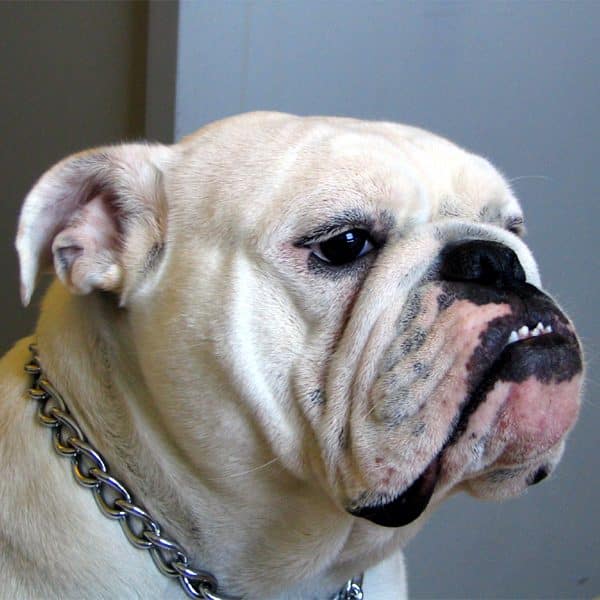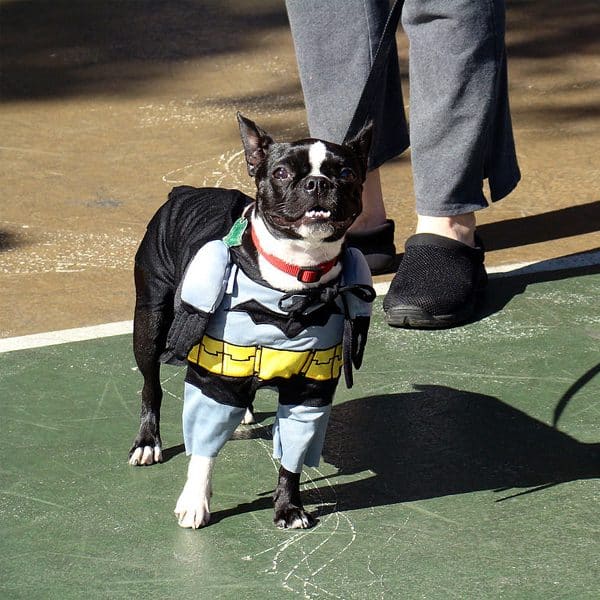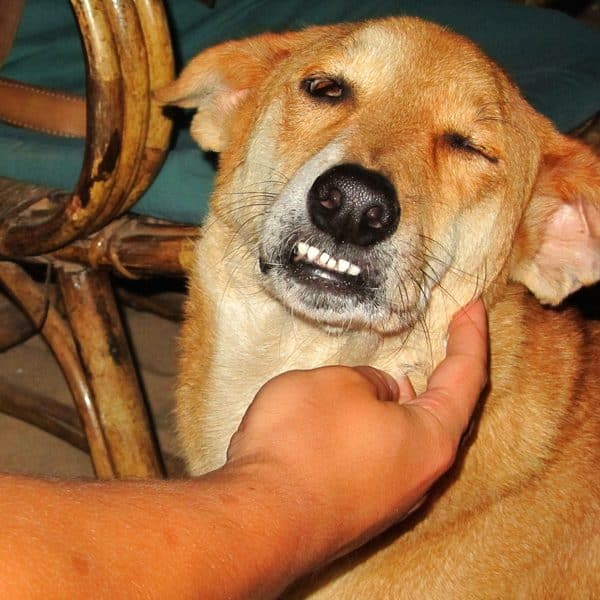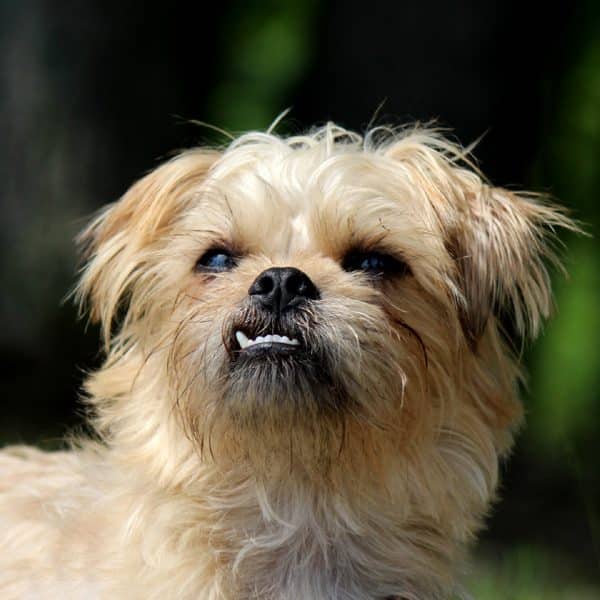The way a dog’s teeth fit together is called occlusion. Dogs, it should surprise no one, are a different species than humans, and how our jaws meet and mesh is accordingly distinct. Where our standard occlusion sees the top row of teeth mirroring those below, the typical occlusion for a dog’s mouth is called the scissor bite. This means that when a dog’s mouth is closed, the canine teeth and the premolars just behind them meet like the blades on a pair of scissors. We’ve all seen dogs whose lower jaw is more pronounced, often leading to the bottom teeth poking out when they are at rest. This type of malocclusion is seen in dogs with underbites.

An underbite interferes with upper and lower teeth alignment. (Photo via Wikimedia)
Upper and lower jaw and teeth alignment can be a bit tricky in dogs. As long as a dog can comfortably chew and eat solid food and their bite is functional, an underbite malocclusion can be considered both normal and healthy. In fact, among certain breeds, usually flat-faced or brachycephalic dogs, the lower dog jaw is typically a little longer than the upper. A dog with an underbite where only the jaw is affected is a skeletal malocclusion. Let’s examine this structural phenomenon with a focus on the following points:
- What constitutes a canine underbite?
- What causes an underbite?
- Dog breeds with underbites
- Is having an underbite bad?
- Can a dog underbite be fixed?
What’s an underbite?
The kind of underbite we’re looking at in this article is a Class 3 malocclusion. There are actually a number of technical and medical terms for the condition, including mandibular prognathism and mandibular mesioclusion. All of them refer to the same relative positioning of the teeth situated in the lower and upper jaws, where the dog’s lower jaw sticks out beyond the upper jaw. The malocclusion occurs because the result of different jaw lengths causes the teeth to meet in atypical ways.

Dogs with bottom teeth sticking out, like Bat-dog, are a common sight. (Photo via Wikimedia)
What does an underbite look like? The photos of dogs with underbites scattered throughout this article give you a good idea. The lower jaw may be, or appear, physically longer than the upper, or situated in such a way that the dog’s bottom teeth are visible even when the dog’s mouth is closed. A dog with an underbite who also has teeth that are themselves also jagged or misaligned falls under a different category, called a dental malocclusion.
What causes an underbite?
Most of us have some idea of how the practice of pure-breeding has affected the skeletal structure of dogs through the years. In certain short-muzzled, or brachycephalic, dog breeds, the establishment of breed standards is a major reason why skeletal malocclusion is not only considered normal, but necessary among dogs raised to compete in conformation shows. When you watch dog shows and see judges poking around in a dog’s mouth, it is usually so that they can check the dog’s occlusion (or malocclusion) against what is formally required by the breed standard.
In dogs from breeds and mixes whose muzzles are more pronounced, a slight underbite during the first stages of life may self-correct as the baby teeth are discarded and the adult teeth come in. The rule of thumb is that by the age of 10 months, the alignment of a dog’s teeth is set. Dental malocclusion is another cause of a persistent underbite in dogs of otherwise normal muzzle length. Teeth can become misaligned when a dog’s baby teeth fail to come in and fall out as they should. This problem can affect any dog, but is most frequently seen in small and toy dog breeds.
What dog breeds have underbites?
Among certain breeds, as well as mixes where one of these breeds is a contributor, an underbite is considered normal. The cause for this, then, is genetic, a structural abnormality that has become not only expected, but desired. Breeds for whom a skeletal malocclusion is a common feature include the Boston Terrier, Boxer, Bulldogs (English and French), Cavalier King Charles Spaniel, Lhasa Apso, Pekingese, Pug and the Shih Tzu. Mixed-breed dogs with at least one parent from among that list are also a greater likelihood of developing, or being born with, an underbite.

Our lists of dogs with underbites is not comprehensive. (Photo by Molesworth II on Flickr)
As mentioned above, for some dogs, an underbite is the result of deciduous teeth that are either impacted, or, when they do erupt, emerge irregularly. This is the most common scenario for underbites in non-brachycephalic dogs, although it happens much more often in breeds such as the Chihuahua, Maltese, Pomeranian and Yorkshire Terrier, especially in their toy and teacup varieties.
Dog underbite problems
Is having an underbite bad? In dogs for whom skeletal malocclusion is hereditary, their slight underbite is no cause for concern. There is usually no appreciable negative impact on the way their mouths function for eating, drinking, self-grooming and other mundane tasks. Cases like these can be monitored throughout a dog’s life during regular exams and checkups.
Dental malocclusion, on the other hand, can lead to serious health issues. When bite mesh issues are caused by jagged, awkwardly emerging or impacted teeth, normal functioning can be impaired. An inability to tear and grind food is among the problems a dog with a more severe underbite can suffer. More detrimental things happen when a tooth comes in wrong, doing unintended damage or wounding sensitive parts of the mouth, whether the cheek, gums or the roof of a dog’s mouth.
Dog orthodontics: Can an underbite be fixed?
The vast majority of cases of skeletal malocclusion require no treatment. If a misaligned tooth is at no risk of causing damage to a dog’s mouth, usually it can be left alone as well. However, physical traumas from misaligned teeth that make regular and inappropriate contact with the mouth’s interior can lead to complications like infections and formation of cysts, and can even accelerate the process of tooth decay. Baby teeth that do not erupt properly or remain impacted can also lead to pain and suffering.

This dog’s jagged tooth shouldn’t cause any harm. (Photo via Public Domain Pictures)
Can a dog underbite be fixed? If the problem, or the potential for underbite development to cause substantive health issues, exists, canine dental specialists have options in these latter scenarios, though they can be costly. After determining the nature of the problem and the areas affected, solutions can range from extracting errant teeth and dog braces to corrective surgery.
The post Canine Malocclusion: Dogs with Underbites appeared first on Dogster.
No comments:
Post a Comment